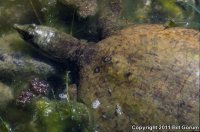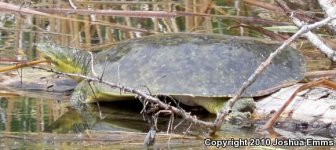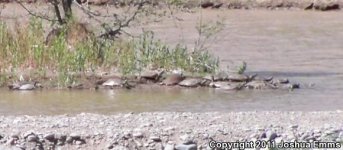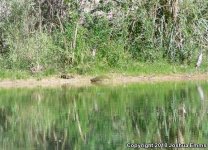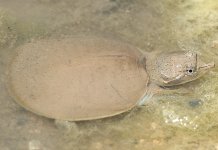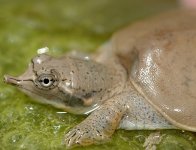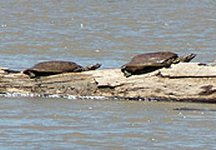| Range: |
 |
| Other Names: |
|
| Subspecies: |
Texas Spiny Softshell Apalone spinifera emoryi Juvenile pattern of white dots confined to rear 1/3 of carapace. Pale border conspicously widened, 4-5 times wider at rear than at sides. Pattern on head and limbs reduced.
Eastern Spiny Softshell Apalone spinifera spinifera Retains juvenile pattern of small ocelli, or solid black dots, on carapace. Only 1 dark marginal line separates pale border of carapace from dorsal ground color; pale border not conspicuously widened toward rear. Bold pattern of adark and light markings on head and limbs. |
| Description: |
5 - 21 inches in shell length (12.7 - 53.3 cm). A very flat turtle with a rounded, leathery-skinned, flexible, shell which is keelless and unhinged. The snout is long with open nostrils on the end. The limbs are flat with broadly-webbed feet. Color is olive, brown or grayish, sometimes with dark markings which fade with age. The head and limbs are olive to gray with dark markings. Two dark-bordered light stripes mark each side of the head, extending from the back of the eye and from the back of the angle of the jaw. The shell has a yellowish border with a dark line around it. The carapace is rimmed with pale coloring which is four to five times wider on the rear than on the front and sides. There are pale conical spiny projections (tubercles) along the rear third of the shell. The plastron is yellowish and unmarked. Males are smaller than females with a thick tail that extends beyond the carapace, and their pattern is more contrasted than that of females.
The shell has a sandpaper-like texture. Females become more blotched and mottled as they get older and have a smoother shell with well-developed warts on the front edge. Juveniles have prominent dark markings on the head and the limbs and black spots on the shell. |
| Similar Species: |
The Smooth Softshells lack spines, bumps or sandpapery projections on carapace and don't have ridges on nostrils. |
| Habitat: |
Found in permanent, not temporary, rivers, agricultural canals, drainage ditches, artificial lakes and ponds. Prefers still water with a muddy, sandy, or gravelly bottom, and aquatic vegetation.
|
| Behavior: |
Diurnal. Thoroughly aquatic, but basks out of the water. Active most of the year, becoming dormant in cold temperatures. Often remains hidden underwater with the snout extended up to the surface to breathe. Turtles sometimes leave the water to search for food, a better place to live, a mate, or to lay their eggs in the spring - typically from March to June. If you see a turtle walking on the land, it is probably not sick or lost, so the best thing you can do for the turtle is to leave it alone. Some people want to help a turtle they think is in danger by picking it up and bringing it home or to a wildlife rehabilitation center, but most of the time this harms the turtle by removing it from the wild without reason. Sometimes turtles do get lost or stranded in yards or on busy roads or somewhere where they may be in danger. If you find one in such a situation, it's ok to move it out of danger, but it's best to leave it in a safe place as close to where you found it as possible. Difficult to approach, moves very fast on land and in the water. Capable of scratching vigorously and producing a painful bite if handled. |
| Hibernation: |
|
| Reproduction: |
From May to August, females crawl onto land to lay 1 or 2 clutches of 3 - 39 eggs on exposed, sunny, sandy banks. Hatchlings emerge from August to October. |
| Diet: |
Predominately carniverous. Eat insects, crayfish, worms, snails, fish, frogs, tadpoles, and reptiles.
Both actively hunts its prey and sits still to ambush passing prey. May also scavenge its food. |
Adapted from account on californiaherps.com
Sources:



|




